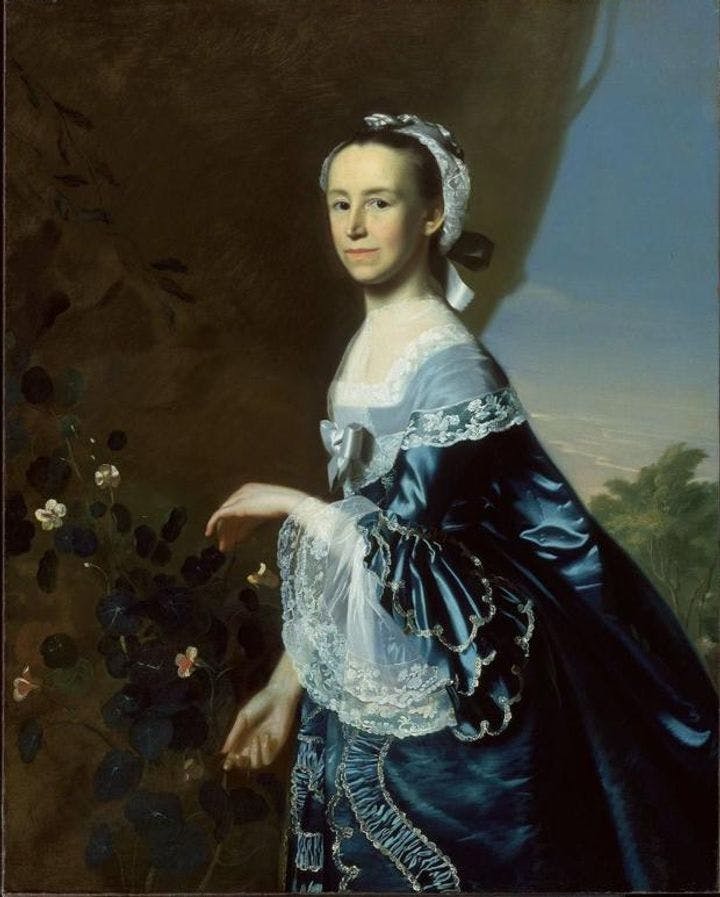Summer 2008
Meet Mrs. Warren
– Edith Gelles
Edith Gelles looks at the muse of the American Revolution, Mercy Otis Warren.
Mercy Otis Warren’s reputation is based largely on her magnum opus, the incomparable History of the Rise, Progress and Termination of the American Revolution. Published in 1805, it is one of the earliest histories of that era. That an 18th-century woman was inspired to believe she could write history—indeed, did write it—is remarkable. Still, today herHistoryis hardly known, much less read outside the circle of scholarly specialists on the revolutionary era. Unlike that of her friend Abigail Adams, Warren’s place in the pantheon of the American Revolution has been shortchanged, even ignored, in the stream of recent popularizations of the founding “greats.” Given her extraordinary accomplishments and the paucity of records on women of that era, this neglect is unfortunate.
Born in 1728 into the large, affluent, and politically influential Otis family of Barnstable, Massachusetts, Mercy married James Warren, a politician and gentleman farmer from Plymouth, in 1754. She bore five sons, three of whom suffered tragic ends, lending her life a sad undercurrent. She befriended most of the leaders of the American Revolution, including, early in his career, John Adams, who introduced his young wife to this formidable matron, knowing that theirs would be a rare combination of domestic and intellectual compatibility. Warren’s correspondence was far flung among politicians and literati of the period—including the British historian Catharine Sawbridge Macaulay and friends, Hannah Winthrop, and Ellen Lothrop. She published—pseudonymously, of course—poetry and plays in public journals, often on political themes.
Until Warren’s death in 1814, she and Abigail Adams continued to correspond. Her friendship with John Adams was more vexed. During his vice presidency, she asked for political favors for her husband and sons that he declined to grant on the grounds that doing so would be favoritism. Thereafter their friendship cooled, especially as the Warrens, disillusioned by their antipathy to the new constitution and by the postwar depression that devastated their fortune, broke politically with Adams. In her History,Warren included few mentions of Adams, and those she did make he found disparaging, a slight that resulted in a prolonged and heated exchange that terminated their friendship for several years.
Aside from the customary male slant in American history, other reasons account for Warren’s invisibility. Though related to important men of the period, she was not the wife of a president, as was Abigail Adams. Furthermore, fewer of her s surviving s elegant prose.
In a 1774 letter to Abigail Adams, for example, Warren wrote of her concern that American institutions not be subverted by the First Continental Congress: “I hope they will have no uncommon Dificulties to surmount or Hostile Movements to impede them, but if the Locrians should interrupt them, tell him [John Adams] I hope they will beware that no future annals may say they Chose an ambitious Philip for their Leader, who subverted the Noble order of the American Amphyctiones; and Built up a Monarchy on the Ruins of the Happy institution.”
Nancy Rubin Stuart, the author of several popular biographies of women, presents Warren in a colorfully anecdotal style. Given the difficulty of reconstructing Warren’s life, Stuart has artfully set the story in the context of the Revolution and relied upon her subject’s friendships, especially with the Adamses. The pace is brisk, if not jaunty. But the history is marred by small errors. The stamp tax was an internal, not an “external,” tax. Abigail Adams’s sisters were Mary Cranch and Elizabeth Shaw, not Elizabeth Cranch and Mary Shaw. And Stuart is too susceptible to conjecture, relying on qualifiers such as “may have” and “probably.”
All in all, Stuart does not satisfactorily support the exaggerated claim of the title, that Warren was the secret muse to the Revolution. But Warren’s intelligence, her erudition, her patriotism, her political commentary, her well-lived life, deserve attention. As a lively introduction to the great Mercy Otis Warren, this book is appealing. But to the student of history, Rosemarie Zagarri’s A Woman’s Dilemma: Mercy Otis Warren and the American Revolution(1995) still stands as the best biography.
* * *
Edith Gelles, a senior scholar at the Michelle R. Clayman Institute for Gender Research at Stanford, is the author of Abigail and John: Portrait of a Marriage, forthcoming next year, among other books.
Reviewed: "The Muse of the Revolution: The Secret Pen of Mercy Otis Warren and the Founding of a Nation" by Nancy Rubin Stuart, Beacon, 2008.
Image by John Singleton Copley, courtesy of Wikimedia Commons
Up next in this issue
